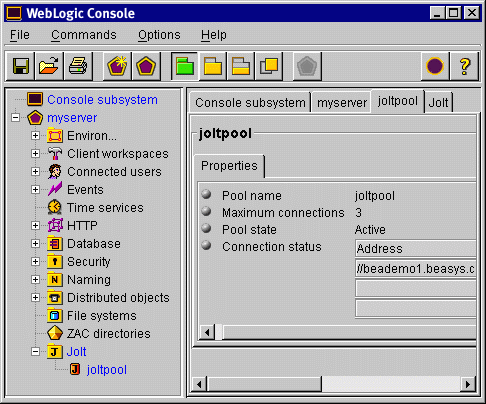


|

|
|
| |
Configuring Jolt for WebLogic
Configuring a Jolt Session Pool connection between Tuxedo and WebLogic requires two procedures:
Refer to the Jolt User's Guide for instruction on setting up a Jolt Service Listener (JSL) within Tuxedo. In the Jolt User's Guide it is assumed that JSL services have already been configured within the Tuxedo domain. The guide only describes how to establish a session pool connection to these services from WebLogic.
Configuring Jolt for WebLogic
This section describes how to set up a BEA Jolt connection pool between the WebLogic Server and the JSL in the Tuxedo domain. Your WebLogic Server must have access to the host running the JSL.
Jolt Startup Properties
You must instruct WebLogic to invoke the PoolManagerStartUp class whenever the WebLogic Server is started or restarted. This invocation establishes the pool connection to Tuxedo from the weblogic.properties file, as shown in the following example.
weblogic.system.startupClass.joltpool=\
bea.jolt.pool.servlet.weblogic.PoolManagerStartUp
weblogic.system.startupArgs.joltpool=\
poolname=myJoltPool,\
appaddrlist=//tuxserver:8000;//tuxserver:9000,\
failoverlist=//tuxserver:9090,\
minpoolsize=1,\
maxpoolsize=3
These example properties are already included in the default WebLogic properties file, but they are commented out. In order to make the properties take effect, you must find them, adjust them for your system configuration, and uncomment them. Then start (or restart) the WebLogic Server.
The first property in the preceding example (weblogic.system.startupClass.joltpool) instructs WebLogic to invoke the PoolManagerStartUp class when the WebLogic Server starts. The second property (weblogic.system.startupArgs.joltpool) specifies initialization arguments that are passed to the PoolManagerStartUp class. These arguments are defined as follows:
|
poolname |
(Optional) Defines a name for this session pool that should be unique from the names of other session pools. This is an optional argument, but it is recommended that you use it to avoid ambiguity. The SessionPoolManager allows only one session pool to remain unnamed. You can access this unnamed session pool from your application by supplying null in place of the poolname string argument to the getSessionPool() method. Note: We strongly recommend that you name every session pool. |
|
appaddrlist |
(Required) Defines a list of the addresses of the primary Jolt Server Listeners (JSLs) on the Tuxedo system. It is the JSLs that service your servlet's Jolt requests. These are defined in the format: Note: You must specify at least one primary JSL hostname:port address. |
|
failoverlist |
(Optional) You can specify a list of failover Jolt Server Listeners in the same format used for appaddrlist above. Jolt attempts to use these failover JSL(s) if the primary JSLs listed above fail. These JSLs need not reside on the same host as the primary JSLs. |
|
minpoolsize |
(Required) Specifies the initial session pool size when the session pool is created. |
|
maxpoolsize |
(Required) Specifies the maximum session pool size. Each session within a pool can handle up to 50 outstanding requests at any one time. |
|
username |
(Optional) Tuxedo user name. This is required only if the Tuxedo authentication level is USER_AUTH. |
|
userpassword |
(Optional) Tuxedo user password. This is required only if the Tuxedo authentication level is USER_AUTH. |
|
userrole |
(Optional) Tuxedo user role. This is required only if the Tuxedo authentication level is USER_AUTH or APP_PW. |
|
apppassword |
(Optional) Tuxedo application password. This is required only if the Tuxedo authentication level is USER_AUTH or APP_PW. |
It is recommended that you configure one Jolt session pool for each application running on the WebLogic Server.
Jolt Shutdown Properties
Configure WebLogic to disconnect the Jolt session pools from Tuxedo when it shuts down by adding the following lines to the WebLogic properties file (or uncommenting the appropriate lines if they already exist).
weblogic.system.shutdownClass.joltapp=\
bea.jolt.pool.servlet.weblogic.PoolManagerShutDown
weblogic.system.shutdownArgs.joltapp=\
poolname=myJoltPool
where myJoltPool is the name of the Jolt pool to be disconnected at shutdown.
The first property instructs WebLogic to invoke the PoolManagerShutDown class when the WebLogic Server shuts down. The second property describes arguments passed to the PoolManagerShutDown class, defining the poolname of the Jolt session pool to be closed. The second property is associated with the first through the virtual name binding-in this case, joltapp. The poolname will be specific to your application.
Displaying Jolt in the WebLogic Console
If you are connecting to a WebLogic Server that has Jolt correctly installed and configured, when you start the WebLogic Console you will see a managed object for the Jolt connection pool displayed in the WebLogic Console, as shown in Figure 2-1.
Figure 2-1 WebLogic Server Console with Jolt Connection Pool

For each Jolt connection pool there is an individual ManagedObject that displays the pool name, maximum connections, pool state, and statistics about the connection status.

|
|
|
Copyright © 2000 BEA Systems, Inc. All rights reserved.
|